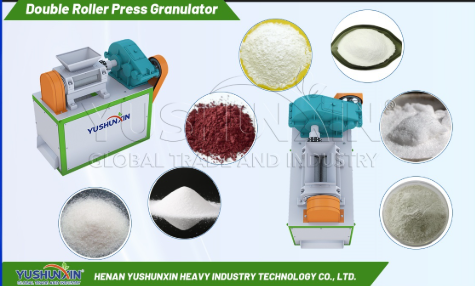In the field of biofertilizer manufacturing, achieving uniform and stable granules without excessive moisture or energy use is often a challenge. The roller compactor granulator, also known as a double roller press granulator, offers a reliable dry granulation method that helps turn organic and microbial materials into durable biofertilizer pellets. However, to get the best performance from this machine, a few technical considerations should be kept in mind.
1. Optimize the Raw Material Composition
The success of any biofertilizer granulation process starts with the raw materials.
Roller granulators work best with powders that have:
- A moisture content between 5%–10%,
- Uniform particle size and fine texture,
- Proper organic–inorganic ratio to improve adhesion.
If the materials are too wet, they can stick to the rollers; too dry, and the granules may crumble after compaction. Many producers pre-condition the material using mixers or moisture controllers to maintain this balance. If you are unsure how to process the raw materials, please feel free to contact YUSHUNXIN.

2. Control the Pressure and Roller Gap
One of the main advantages of dry granulation equipment is its ability to adjust granule density through pressure.
- Higher pressure results in harder, denser pellets, suitable for long storage and transportation.
- Lower pressure yields lighter granules with faster nutrient release.
The roller gap should be adjusted according to the bulk density and compressibility of the feed material. Regular monitoring prevents roller sheet wear and ensures consistent granule quality.
3. Maintain Proper Feeding and Roller Speed
Uneven feeding often leads to irregular granules or equipment blockage.
Using a stable feeding system—such as a screw or belt feeder—helps achieve continuous compaction. The roller speed should also match the feeding rate; overly high speed can cause material slip, while too low may reduce production efficiency.
4. Regular Maintenance and Surface Cleaning
Over time, the roller surface can become coated with residues from organic matter, especially when producing microbial biofertilizers. Routine cleaning not only prevents contamination but also extends the machine’s lifespan.
Producers should also check:
- Roller surface smoothness,
- Bearing lubrication,
- Alignment of compression rolls.
These small adjustments can significantly enhance the output rate of the biofertilizer compaction granulator. Learn more!
5. Integrating with Other Units
A roller granulator system often works together with crushers, sieving machines, and automatic packaging units. Matching the capacity of each section prevents bottlenecks in production and ensures stable fertilizer quality from start to finish. If you need a roller granulation equipment, welcome to visit: https://www.biofertilizerproduction.com/product/roller-compactor-granulator-for-bio-fertilizer-manufacturing/
